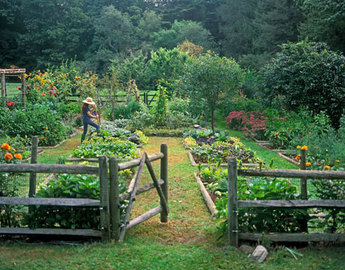Introduction

When it comes to gardening, raising homegrown vegetables can be one of the most rewarding efforts of all. A vegetable patch has lush, green foliage and flowers in many colors and forms. But best of all, the fresh food that the garden provides is full of nutrients. It's beautiful, as well. The shiny, deep-purple skin of ripe eggplants, the bright orange of carrots and the subtle green of zucchini all have beauty and grace. Succulent homegrown tomatoes, fresh-picked snap beans and delicate, leafy green lettuce bring delicious flavors to your dinner table. Whether you have a small property, sizeable yard or just a patio with pots, raising your own vegetables saves money at the grocery store.
History
Producing homegrown food used to be a necessity, but with increased transportation capabilities over the last century, many families came to rely on their grocer to provide vegetables. Pure, fresh flavors were hard to come by because many of the vegetables had to be picked before their prime and stored before they made it to the grocery store produce department. Families that had a little property often raised their own homegrown vegetables for fresh eating and to preserve for use in the winter months. As grocery prices increased and the economy became difficult, more and more families transformed a portion of their property into vegetable gardens. In many cases, raising homegrown vegetables moved from being a hobby to a routine activity in order to save money on fresh food.
Features
Well-prepared soil yields the highest volume of high-quality homegrown vegetables. A big part of gardening is adding compost and organic material to the ground before planting seeds or vegetable plants. Make your own compost from kitchen scraps, leaves and grass clippings. Many municipalities have composting centers where you can obtain material to work into your own ground in preparation for planting.
Growing food from seed can be fun, but planting some vegetables that have already been started in a nursery gives you a head start. Tomatoes, peppers, eggplants and cucumbers all do best when you set out plants. For corn and root vegetables like carrots, beets and bunching onions, plant the seeds directly in the soil when the ground has warmed from the spring sunshine.
Good watering practices ensure plump, well-formed homegrown vegetables. Apply water frequently to seedlings and newly planted vegetables. When the plants are established, reduce the frequency of watering and increase the volume to ensure that the roots are well hydrated. Spread mulch around plants to retain moisture in the ground. The mulch will also help suppress weeds from growing in the vegetable garden.
Tips and comments
To grow organic vegetables, check the labels on fertilizer carefully before purchase. Also check the labels on pesticides to ensure that the product is recommended for organic gardening practices. Homegrown vegetables that are organic provide your family with untainted nutritional value.
If you live in an apartment, townhouse or condominium, you may not have sufficient space to grow vegetables in the surrounding ground. You can still enjoy the benefits and fresh flavor of homegrown vegetables by raising several plants in pots on your patio or deck. Several varieties of tomatoes, peppers and salad greens thrive in containers as long as they have sufficient sunshine and water.
Comments
Most Recent Articles
-
Great Advice For Home Garden Patio
Creating a home garden patio is more complex than simply sticking with a plain, hard-surface pation that doesn't have any plants or greenery. When you are done with the project, you will dis...
-
How To Grow Green Foods
Leafy green foods are some of the simplest vegetables to grow in your garden. These include lettuce, spinach, chard, kale and mustard greens. Most of these green foods grow during the cooler...